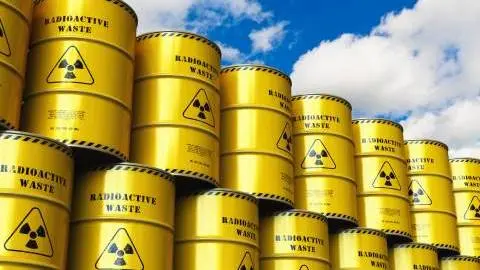EU’s controversial labelling of gas and nuclear energy as ‘green’ prompts backlash
The inclusion of nuclear and fossil gas activities under the EU taxonomy has called into question whether the green classification system will still be fit for purpose
The past years’ trail of regulatory developments in the field of sustainability has made it abundantly clear that climate change has top priority in Europe. The EU taxonomy regulation is probably the most far-reaching piece of evidence of the block’s efforts to guide investment towards environmentally sustainable activities, while avoiding greenwashing in the process. However, the European Commission’s recent plans to accept certain nuclear energy and fossil gas activities as environmentally sustainable has raised questions about whether the bar set by the taxonomy will still be high enough.
The EU taxonomy regulation came into force on 12 July 2020 as a unified classification system for the determination of economic activities that would qualify as being environmentally sustainable.
The EU taxonomy identifies the following six sustainability objectives:
- Climate change mitigation.
- Climate change adaptation.
- Sustainable use and protection of water and marine resources.
- Transition to a circular economy, waste prevention and recycling.
- Pollution prevention and control.
- Protection and restoration of biodiversity and ecosystems.
An economic activity is considered environmentally sustainable, and thus taxonomy aligned, if it meets the following criteria:
- The economic activity contributes substantially to one of the environmental objectives identified.
- The economic activity does not significantly harm any of these environmental objectives.
- The economic activity is carried out in compliance with the minimum safeguards.
- The economic activity complies with the technical screening criteria, defining the ‘substantial contribution’ (SC) and ‘do no significant harm’ (DNSH) standards.
Three types of environmentally sustainable activities are distinguished:
- Low-carbon activities that, by themselves, contribute substantially to the taxonomy’s objectives.
- Transition activities that have no feasible low-carbon alternatives but do support the transition to climate neutrality.
- Enabling activities that help other activities make a substantial contribution to the taxonomy objectives.
The climate delegated act of 4 June 2021 defines the technical screening criteria for economic activities contributing substantially to the climate change mitigation and climate change adaptation objectives and is applicable since 1 January 2022.
The role of energy activities within the EU taxonomy
According to the European Commission, energy use is responsible for 75% of the greenhouse gas (GHG) emissions in the EU. Hence it is not surprising that energy activities play a prominent role in the climate delegated regulation.
Low carbon activities
To give an idea, the climate delegated act identifies no less than 25 environmentally sustainable activities for the energy sector, of which 21 contribute substantially to climate change mitigation (see Figure). These include electricity generation from renewables, such as solar, wind, geothermal or hydropower. For instance, electricity generated via hydropower, geothermal energy or renewable gas is only considered to contribute substantially to the climate change mitigation objective, if the life-cycle GHG emissions from the generation are lower than 100gCO2e per kWh.
Enabling activities
In addition, the climate delegated act distinguishes four enabling activities for the energy sector. The transmission and distribution of electricity is one of them. A substantial contribution to climate change mitigation is delivered if the transmission system is the interconnected European system. Otherwise, 67% of the newly enabled generation capacity in the system should be below the generation threshold of 100gCO2e per kWh, measured on a life-cycle basis over a rolling five-year period. Alternatively, the average system grid emissions factor should be below 100gCO2e per kWh over a rolling five-year period.
Doing no significant harm to other environmental objectives
Economic activities contributing substantially to the climate change mitigation objective are solely taxonomy compliant if they also meet the ‘do no significant harm’ criteria set by the climate delegated act for the other five environmental objectives. To make sure no significant harm is done to the climate change adaptation objective, physical climate risks (eg wildfires, flooding, etc.) material to the activity have to be identified via a robust climate risk and vulnerability assessment (CRVA) proportionate to the scale of the activity and its expected lifespan. Adaptation solutions are implemented to reduce the most important physical climate risks. To avoid doing harm to a transition to the circular economy, several energy activities should (where feasible) use equipment and components of high durability and recyclability, that are easy to dismantle and refurbish. In turn, when it comes to avoiding significant harm to ecosystems an environmental impact assessment (EIA) or screening has to be completed. Where such an EIA has been carried out, the required mitigation and compensation measures for protecting the environment should be implemented.
How will nuclear power and natural gas fit in?
On 2 February 2022, the European Commission adopted the draft complementary climate delegated act defining the technical screening criteria for certain nuclear and gas activities that were not included in the climate delegated act. Nuclear energy was first left out because of the need for a more in-depth assessment of the ‘do no significant harm’ aspects of nuclear waste. Also, natural gas was subjected to further evaluation of its decarbonisation merits before being included. However, to accelerate the shift away from more harmful fossil energy sources towards renewables, six nuclear power and fossil gas-related activities will now be added as transitional, if the complementary climate delegated act becomes final.
Transition activities related to nuclear power
Nuclear activities encompass, for instance, the construction of new nuclear power plants for energy generation, using the best available existing technologies, with a construction permit issued by 2045. They also include lifetime extension modifications of existing nuclear installations authorised by 2040 at the latest. Electricity generated by nuclear energy is subject to the life-cycle GHG emissions threshold of 100gCO2e per kWh also applicable to several renewable energy sources. However, to address environmental safety concerns, the technical screening criteria for nuclear energy do stretch beyond the applicable EU legal requirements on radioactive waste management. Not only do low-level waste disposal facilities have to be operational already, EU member states should also have detailed plans in place to have disposal facilities for high-level radioactive waste in operation by 2050. In addition, the technical screening criteria explicitly prohibit the disposal of radioactive waste in other member states, unless there is an agreement and the other member state has a suitable disposal facility in place.
Transition activities related to fossil gas
Electricity generation via fossil gas can also contribute substantially to climate change mitigation if the life-cycle GHG emissions are lower than the threshold of 100gCO2e per kWh. However, to speed up the transition away from solid fossil fuels, the technical screening criteria also permit certain fossil gas activities not restricted by this threshold. For fossil gas-related generation facilities with a construction permit granted before the end of 2030, a cap of 270g CO2e per kWh for direct GHG emissions applies. Otherwise, the annual direct GHG emissions should not exceed an average of 550kg CO2e per kWh of the facility capacity over 20 years. In this case, the facility should replace a more polluting plant, leading to a lifetime reduction in GHG emissions of at least 55%. Besides, it should be designed to switch to full use of renewable or low-carbon resources by 2035.
The controversies on nuclear energy and fossil gas
When it comes to the EU taxonomy, perhaps little has caused as much controversy thus far than the idea of accepting nuclear energy and fossil gas activities as environmentally sustainable. While for nuclear energy the environmental benefits as a clean source of energy are commonly acknowledged, the idea that nuclear waste can be disposed of without doing environmental harm elsewhere in the process is still far from commonly accepted. Instead, the use of fossil gas may indeed speed up the transition away from more polluting energy resources, such as coal, but it is not free from GHG emissions. As such, some – including the platform on sustainable finance – do fear that considering these activities as environmentally sustainable will undermine the taxonomy.
Implications for the green bank bond market
The differences in opinion regarding the role of nuclear energy and fossil gas in greening the economy also raises questions regarding the enthusiasm of investors to finance these transitional activities. A case in point is the open letter published by the Institutional Investor Group on Climate Change (IIGCC) in January stressing the difficulties for investors to stay aligned with the EU’s 2050 climate neutrality ambitions, in the event that fossil gas is included in the EU taxonomy.
Besides, some investors and investment funds explicitly exclude fossil gas and nuclear energy activities from their investable universe and may continue to do so irrespective of the inclusion of these activities in the taxonomy. In line with the recommendation of the platform of sustainable finance, the final draft complementary climate delegated act now makes a better distinction between nuclear and fossil gas-related activities vis-à-vis other taxonomy aligned disclosures. This does give investors the tool to still assess the taxonomy compliance of their investments, excluding nuclear and fossil gas.
There could be opportunities in the green bond market, albeit not that likely in practice
Nonetheless, the inclusion of nuclear and fossil gas activities as environmentally sustainable within the scope of the EU taxonomy could be supportive to the broader acceptance of these activities as sustainable. This could also offer new growth opportunities for the green bond market. At this point, the financing of nuclear energy projects by means of green bond issuance is still a novelty. Canadian nuclear power provider Bruce Power was the first example of a company issuing a green bond for the purpose of funding the lifetime extension of its nuclear assets in November last year.
To what extent we will also start seeing such examples in the market for green bank bonds remains to be seen. Renewable energy projects are for banks the second-largest use of proceeds category after energy-efficient buildings, judging their euro green supply. However, the existing sustainable bond frameworks of banks would at this stage typically not facilitate proceed allocations towards nuclear or fossil gas related activities. In fact, in many green, social or sustainability bond frameworks nuclear and/or fossil fuel-related activities are part of the exclusionary criteria applied to the use of proceeds.
Even if a bank’s lending criteria were to allow exposure to these activities, for instance subject to the strict provisions of the draft complementary climate delegated act, the financing by banks of nuclear and fossil activities via green bonds may still not become overwhelming. In this regard, it will also be interesting to see how further discussions regarding the EU Green Bond regulation evolves. Under the European Commission’s proposals, the use of proceeds of EU green bonds have to be taxonomy compliant. However, there are members of the European Parliament that would prefer nuclear and fossil gas activities to be excluded from Europe’s future gold standard for green bonds.
With the jury still out on the ultimate impact of the complementary climate delegated act on the financing of nuclear and fossil gas activities, we don’t see any need at this point to increase our euro sustainable bond supply estimates for banks of €75bn for 2022.
This publication has been prepared by ING solely for information purposes irrespective of a particular user's means, financial situation or investment objectives. The information does not constitute investment recommendation, and nor is it investment, legal or tax advice or an offer or solicitation to purchase or sell any financial instrument. Read more
Download
Download article
18 February 2022
EU taxonomy: spotlight on nuclear and gas This bundle contains 2 Articles
